APC308 Financial Management Report: Investment Analysis
VerifiedAdded on 2022/12/09
|13
|3408
|456
Report
AI Summary
This report, focusing on financial management, delves into investment appraisal techniques and valuation methods. It begins with an introduction defining financial management and its importance, followed by a detailed analysis of investment appraisal techniques including payback period, accounting rate of return, net present value (NPV), and internal rate of return (IRR). Calculations for each method are presented, along with a critical evaluation of a new investment proposal. The report further examines the benefits and limitations of various investment appraisal techniques. Additionally, it addresses valuation methods like price-earnings ratio, discounted cash flow, and dividend valuation, providing calculations and interpretations. The conclusion summarizes the findings, reinforcing the significance of these techniques in financial decision-making.
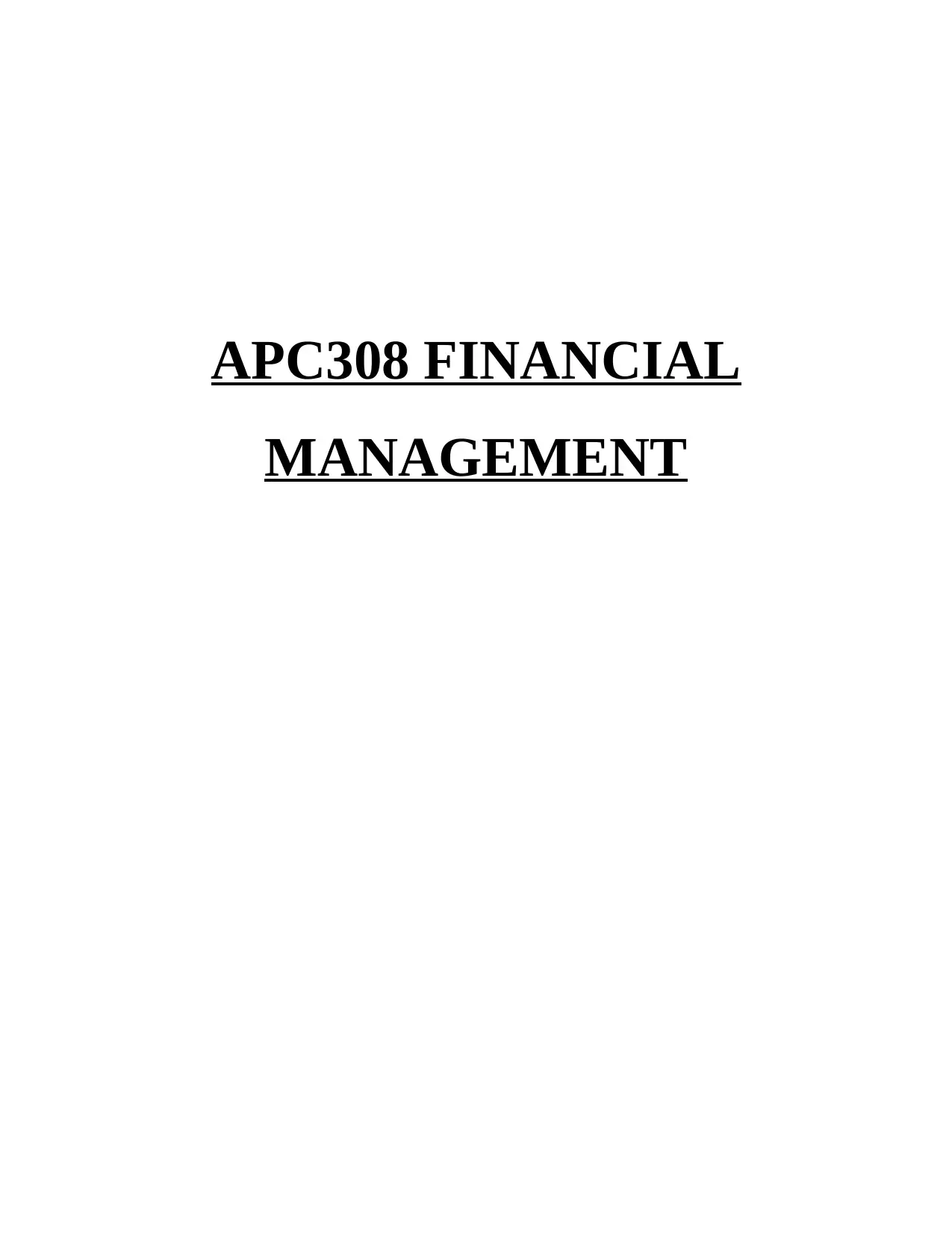
APC308 FINANCIAL
MANAGEMENT
MANAGEMENT
Paraphrase This Document
Need a fresh take? Get an instant paraphrase of this document with our AI Paraphraser
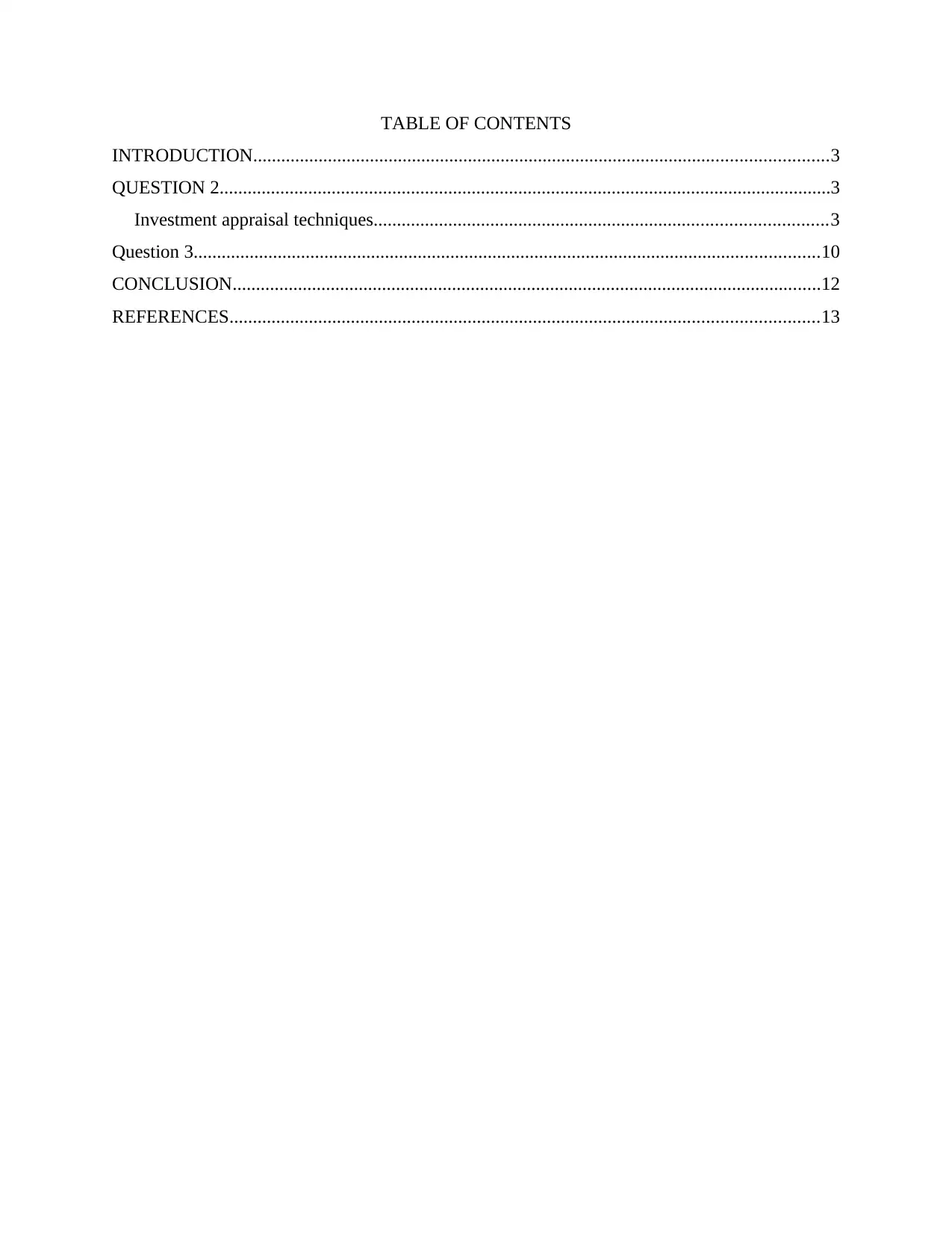
TABLE OF CONTENTS
INTRODUCTION...........................................................................................................................3
QUESTION 2...................................................................................................................................3
Investment appraisal techniques.................................................................................................3
Question 3......................................................................................................................................10
CONCLUSION..............................................................................................................................12
REFERENCES..............................................................................................................................13
INTRODUCTION...........................................................................................................................3
QUESTION 2...................................................................................................................................3
Investment appraisal techniques.................................................................................................3
Question 3......................................................................................................................................10
CONCLUSION..............................................................................................................................12
REFERENCES..............................................................................................................................13
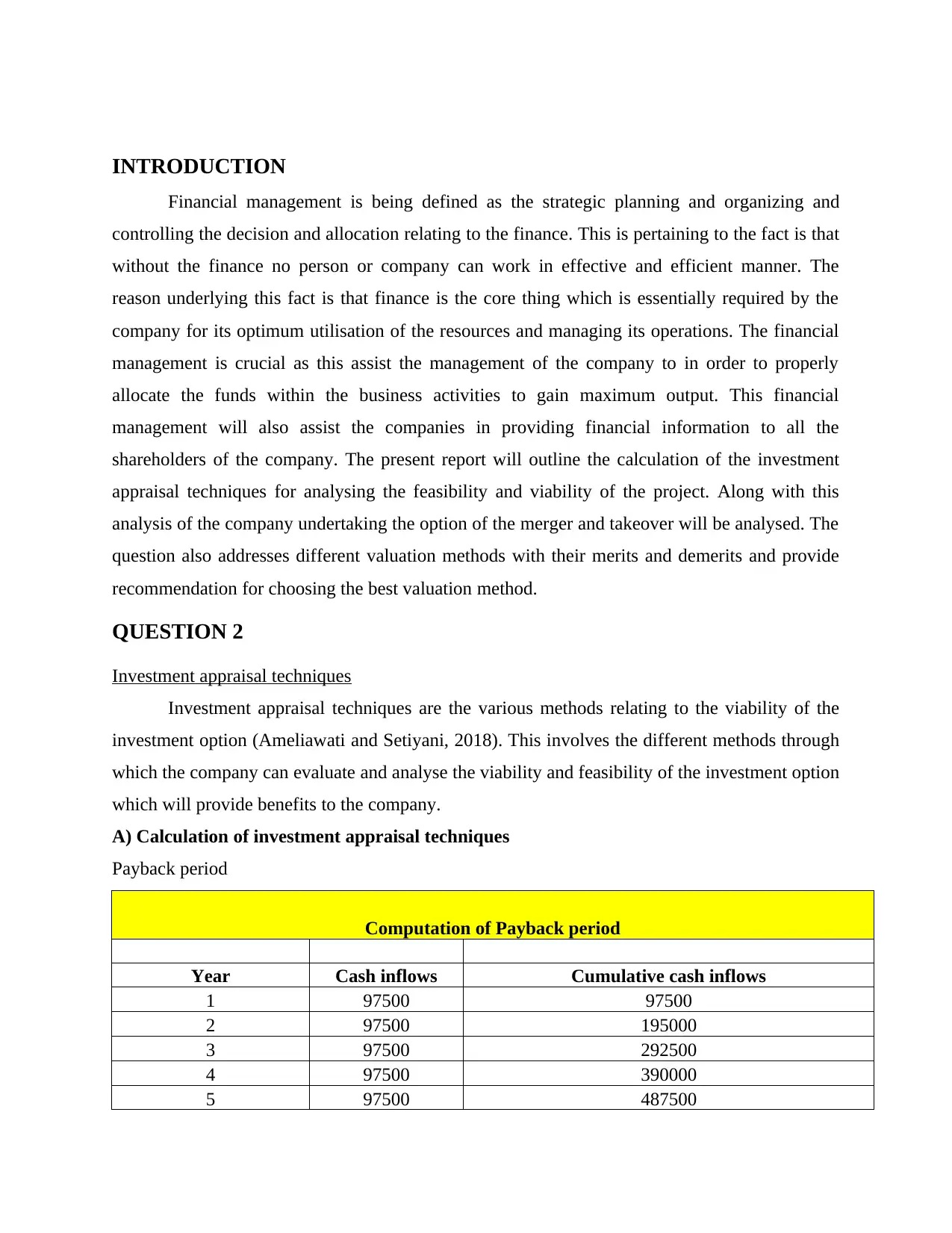
INTRODUCTION
Financial management is being defined as the strategic planning and organizing and
controlling the decision and allocation relating to the finance. This is pertaining to the fact is that
without the finance no person or company can work in effective and efficient manner. The
reason underlying this fact is that finance is the core thing which is essentially required by the
company for its optimum utilisation of the resources and managing its operations. The financial
management is crucial as this assist the management of the company to in order to properly
allocate the funds within the business activities to gain maximum output. This financial
management will also assist the companies in providing financial information to all the
shareholders of the company. The present report will outline the calculation of the investment
appraisal techniques for analysing the feasibility and viability of the project. Along with this
analysis of the company undertaking the option of the merger and takeover will be analysed. The
question also addresses different valuation methods with their merits and demerits and provide
recommendation for choosing the best valuation method.
QUESTION 2
Investment appraisal techniques
Investment appraisal techniques are the various methods relating to the viability of the
investment option (Ameliawati and Setiyani, 2018). This involves the different methods through
which the company can evaluate and analyse the viability and feasibility of the investment option
which will provide benefits to the company.
A) Calculation of investment appraisal techniques
Payback period
Computation of Payback period
Year Cash inflows Cumulative cash inflows
1 97500 97500
2 97500 195000
3 97500 292500
4 97500 390000
5 97500 487500
Financial management is being defined as the strategic planning and organizing and
controlling the decision and allocation relating to the finance. This is pertaining to the fact is that
without the finance no person or company can work in effective and efficient manner. The
reason underlying this fact is that finance is the core thing which is essentially required by the
company for its optimum utilisation of the resources and managing its operations. The financial
management is crucial as this assist the management of the company to in order to properly
allocate the funds within the business activities to gain maximum output. This financial
management will also assist the companies in providing financial information to all the
shareholders of the company. The present report will outline the calculation of the investment
appraisal techniques for analysing the feasibility and viability of the project. Along with this
analysis of the company undertaking the option of the merger and takeover will be analysed. The
question also addresses different valuation methods with their merits and demerits and provide
recommendation for choosing the best valuation method.
QUESTION 2
Investment appraisal techniques
Investment appraisal techniques are the various methods relating to the viability of the
investment option (Ameliawati and Setiyani, 2018). This involves the different methods through
which the company can evaluate and analyse the viability and feasibility of the investment option
which will provide benefits to the company.
A) Calculation of investment appraisal techniques
Payback period
Computation of Payback period
Year Cash inflows Cumulative cash inflows
1 97500 97500
2 97500 195000
3 97500 292500
4 97500 390000
5 97500 487500
⊘ This is a preview!⊘
Do you want full access?
Subscribe today to unlock all pages.

Trusted by 1+ million students worldwide
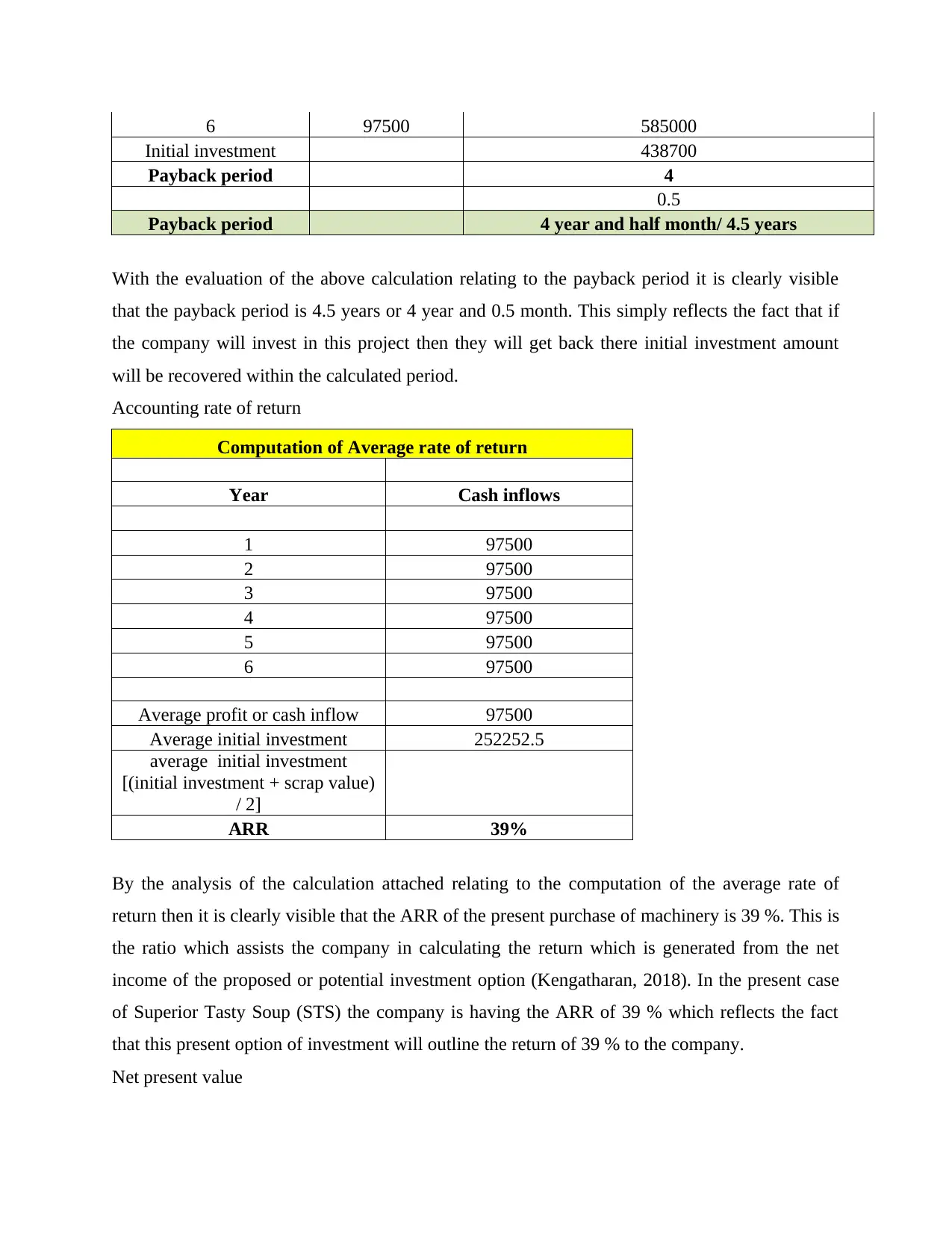
6 97500 585000
Initial investment 438700
Payback period 4
0.5
Payback period 4 year and half month/ 4.5 years
With the evaluation of the above calculation relating to the payback period it is clearly visible
that the payback period is 4.5 years or 4 year and 0.5 month. This simply reflects the fact that if
the company will invest in this project then they will get back there initial investment amount
will be recovered within the calculated period.
Accounting rate of return
Computation of Average rate of return
Year Cash inflows
1 97500
2 97500
3 97500
4 97500
5 97500
6 97500
Average profit or cash inflow 97500
Average initial investment 252252.5
average initial investment
[(initial investment + scrap value)
/ 2]
ARR 39%
By the analysis of the calculation attached relating to the computation of the average rate of
return then it is clearly visible that the ARR of the present purchase of machinery is 39 %. This is
the ratio which assists the company in calculating the return which is generated from the net
income of the proposed or potential investment option (Kengatharan, 2018). In the present case
of Superior Tasty Soup (STS) the company is having the ARR of 39 % which reflects the fact
that this present option of investment will outline the return of 39 % to the company.
Net present value
Initial investment 438700
Payback period 4
0.5
Payback period 4 year and half month/ 4.5 years
With the evaluation of the above calculation relating to the payback period it is clearly visible
that the payback period is 4.5 years or 4 year and 0.5 month. This simply reflects the fact that if
the company will invest in this project then they will get back there initial investment amount
will be recovered within the calculated period.
Accounting rate of return
Computation of Average rate of return
Year Cash inflows
1 97500
2 97500
3 97500
4 97500
5 97500
6 97500
Average profit or cash inflow 97500
Average initial investment 252252.5
average initial investment
[(initial investment + scrap value)
/ 2]
ARR 39%
By the analysis of the calculation attached relating to the computation of the average rate of
return then it is clearly visible that the ARR of the present purchase of machinery is 39 %. This is
the ratio which assists the company in calculating the return which is generated from the net
income of the proposed or potential investment option (Kengatharan, 2018). In the present case
of Superior Tasty Soup (STS) the company is having the ARR of 39 % which reflects the fact
that this present option of investment will outline the return of 39 % to the company.
Net present value
Paraphrase This Document
Need a fresh take? Get an instant paraphrase of this document with our AI Paraphraser
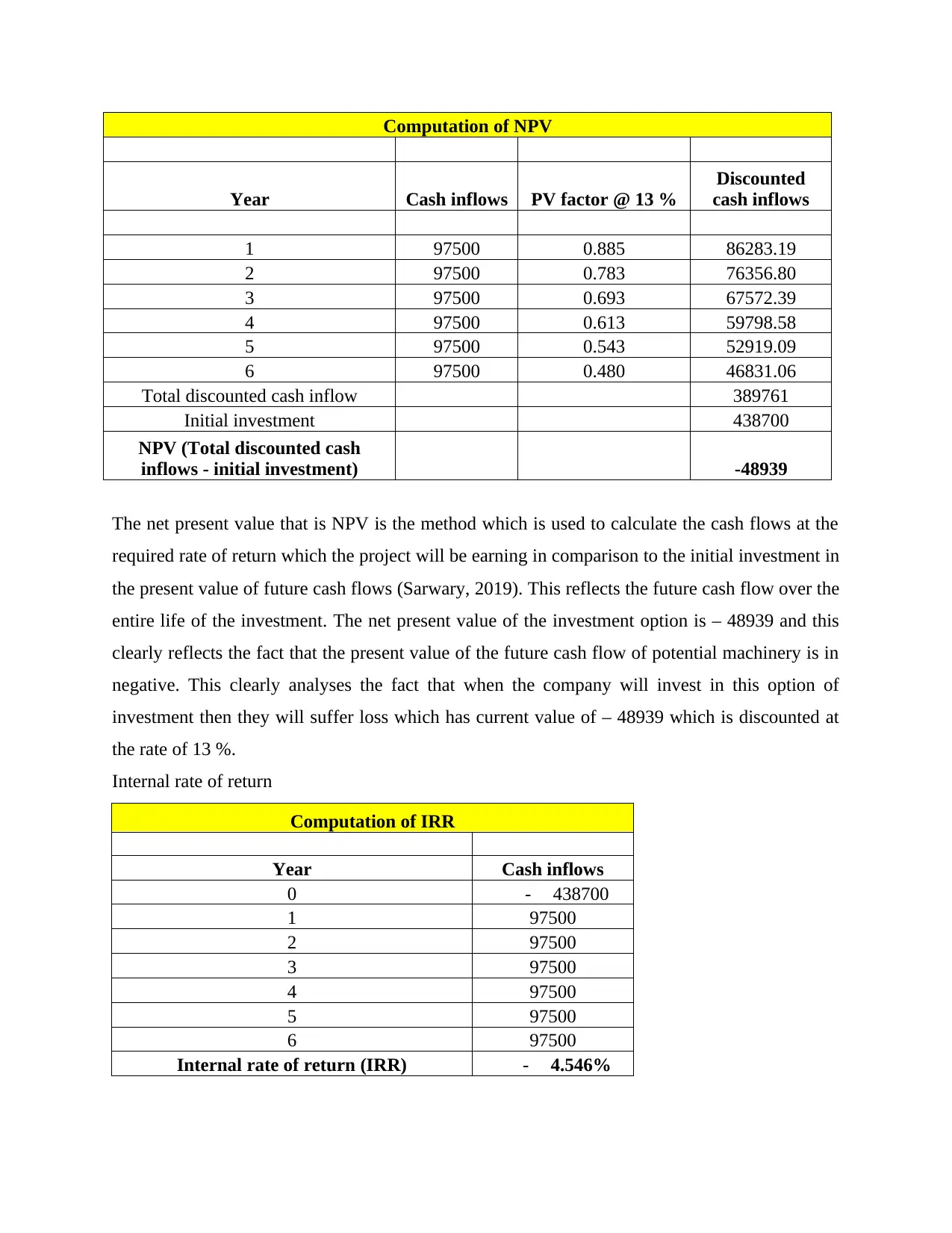
Computation of NPV
Year Cash inflows PV factor @ 13 %
Discounted
cash inflows
1 97500 0.885 86283.19
2 97500 0.783 76356.80
3 97500 0.693 67572.39
4 97500 0.613 59798.58
5 97500 0.543 52919.09
6 97500 0.480 46831.06
Total discounted cash inflow 389761
Initial investment 438700
NPV (Total discounted cash
inflows - initial investment) -48939
The net present value that is NPV is the method which is used to calculate the cash flows at the
required rate of return which the project will be earning in comparison to the initial investment in
the present value of future cash flows (Sarwary, 2019). This reflects the future cash flow over the
entire life of the investment. The net present value of the investment option is – 48939 and this
clearly reflects the fact that the present value of the future cash flow of potential machinery is in
negative. This clearly analyses the fact that when the company will invest in this option of
investment then they will suffer loss which has current value of – 48939 which is discounted at
the rate of 13 %.
Internal rate of return
Computation of IRR
Year Cash inflows
0 - 438700
1 97500
2 97500
3 97500
4 97500
5 97500
6 97500
Internal rate of return (IRR) - 4.546%
Year Cash inflows PV factor @ 13 %
Discounted
cash inflows
1 97500 0.885 86283.19
2 97500 0.783 76356.80
3 97500 0.693 67572.39
4 97500 0.613 59798.58
5 97500 0.543 52919.09
6 97500 0.480 46831.06
Total discounted cash inflow 389761
Initial investment 438700
NPV (Total discounted cash
inflows - initial investment) -48939
The net present value that is NPV is the method which is used to calculate the cash flows at the
required rate of return which the project will be earning in comparison to the initial investment in
the present value of future cash flows (Sarwary, 2019). This reflects the future cash flow over the
entire life of the investment. The net present value of the investment option is – 48939 and this
clearly reflects the fact that the present value of the future cash flow of potential machinery is in
negative. This clearly analyses the fact that when the company will invest in this option of
investment then they will suffer loss which has current value of – 48939 which is discounted at
the rate of 13 %.
Internal rate of return
Computation of IRR
Year Cash inflows
0 - 438700
1 97500
2 97500
3 97500
4 97500
5 97500
6 97500
Internal rate of return (IRR) - 4.546%
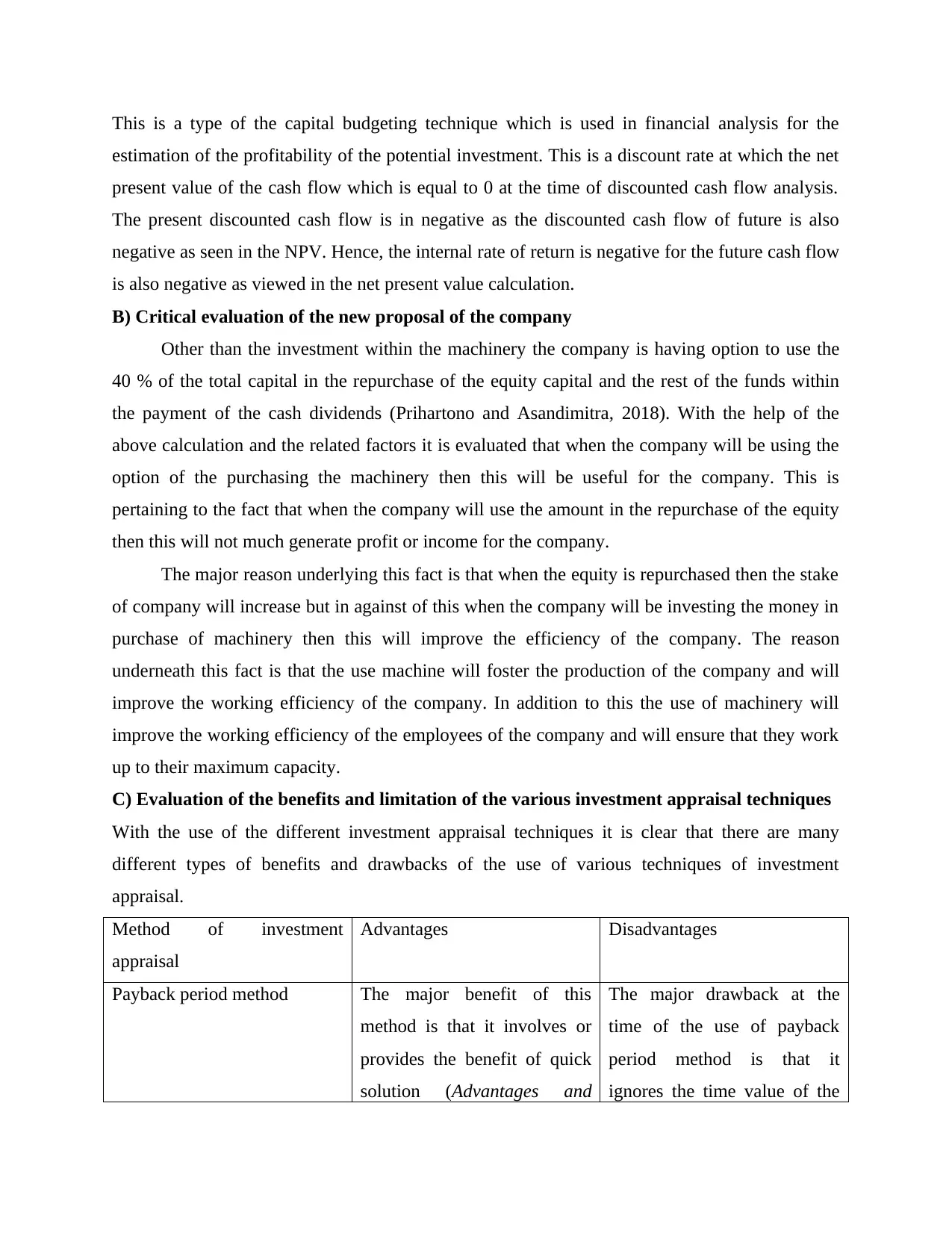
This is a type of the capital budgeting technique which is used in financial analysis for the
estimation of the profitability of the potential investment. This is a discount rate at which the net
present value of the cash flow which is equal to 0 at the time of discounted cash flow analysis.
The present discounted cash flow is in negative as the discounted cash flow of future is also
negative as seen in the NPV. Hence, the internal rate of return is negative for the future cash flow
is also negative as viewed in the net present value calculation.
B) Critical evaluation of the new proposal of the company
Other than the investment within the machinery the company is having option to use the
40 % of the total capital in the repurchase of the equity capital and the rest of the funds within
the payment of the cash dividends (Prihartono and Asandimitra, 2018). With the help of the
above calculation and the related factors it is evaluated that when the company will be using the
option of the purchasing the machinery then this will be useful for the company. This is
pertaining to the fact that when the company will use the amount in the repurchase of the equity
then this will not much generate profit or income for the company.
The major reason underlying this fact is that when the equity is repurchased then the stake
of company will increase but in against of this when the company will be investing the money in
purchase of machinery then this will improve the efficiency of the company. The reason
underneath this fact is that the use machine will foster the production of the company and will
improve the working efficiency of the company. In addition to this the use of machinery will
improve the working efficiency of the employees of the company and will ensure that they work
up to their maximum capacity.
C) Evaluation of the benefits and limitation of the various investment appraisal techniques
With the use of the different investment appraisal techniques it is clear that there are many
different types of benefits and drawbacks of the use of various techniques of investment
appraisal.
Method of investment
appraisal
Advantages Disadvantages
Payback period method The major benefit of this
method is that it involves or
provides the benefit of quick
solution (Advantages and
The major drawback at the
time of the use of payback
period method is that it
ignores the time value of the
estimation of the profitability of the potential investment. This is a discount rate at which the net
present value of the cash flow which is equal to 0 at the time of discounted cash flow analysis.
The present discounted cash flow is in negative as the discounted cash flow of future is also
negative as seen in the NPV. Hence, the internal rate of return is negative for the future cash flow
is also negative as viewed in the net present value calculation.
B) Critical evaluation of the new proposal of the company
Other than the investment within the machinery the company is having option to use the
40 % of the total capital in the repurchase of the equity capital and the rest of the funds within
the payment of the cash dividends (Prihartono and Asandimitra, 2018). With the help of the
above calculation and the related factors it is evaluated that when the company will be using the
option of the purchasing the machinery then this will be useful for the company. This is
pertaining to the fact that when the company will use the amount in the repurchase of the equity
then this will not much generate profit or income for the company.
The major reason underlying this fact is that when the equity is repurchased then the stake
of company will increase but in against of this when the company will be investing the money in
purchase of machinery then this will improve the efficiency of the company. The reason
underneath this fact is that the use machine will foster the production of the company and will
improve the working efficiency of the company. In addition to this the use of machinery will
improve the working efficiency of the employees of the company and will ensure that they work
up to their maximum capacity.
C) Evaluation of the benefits and limitation of the various investment appraisal techniques
With the use of the different investment appraisal techniques it is clear that there are many
different types of benefits and drawbacks of the use of various techniques of investment
appraisal.
Method of investment
appraisal
Advantages Disadvantages
Payback period method The major benefit of this
method is that it involves or
provides the benefit of quick
solution (Advantages and
The major drawback at the
time of the use of payback
period method is that it
ignores the time value of the
⊘ This is a preview!⊘
Do you want full access?
Subscribe today to unlock all pages.

Trusted by 1+ million students worldwide
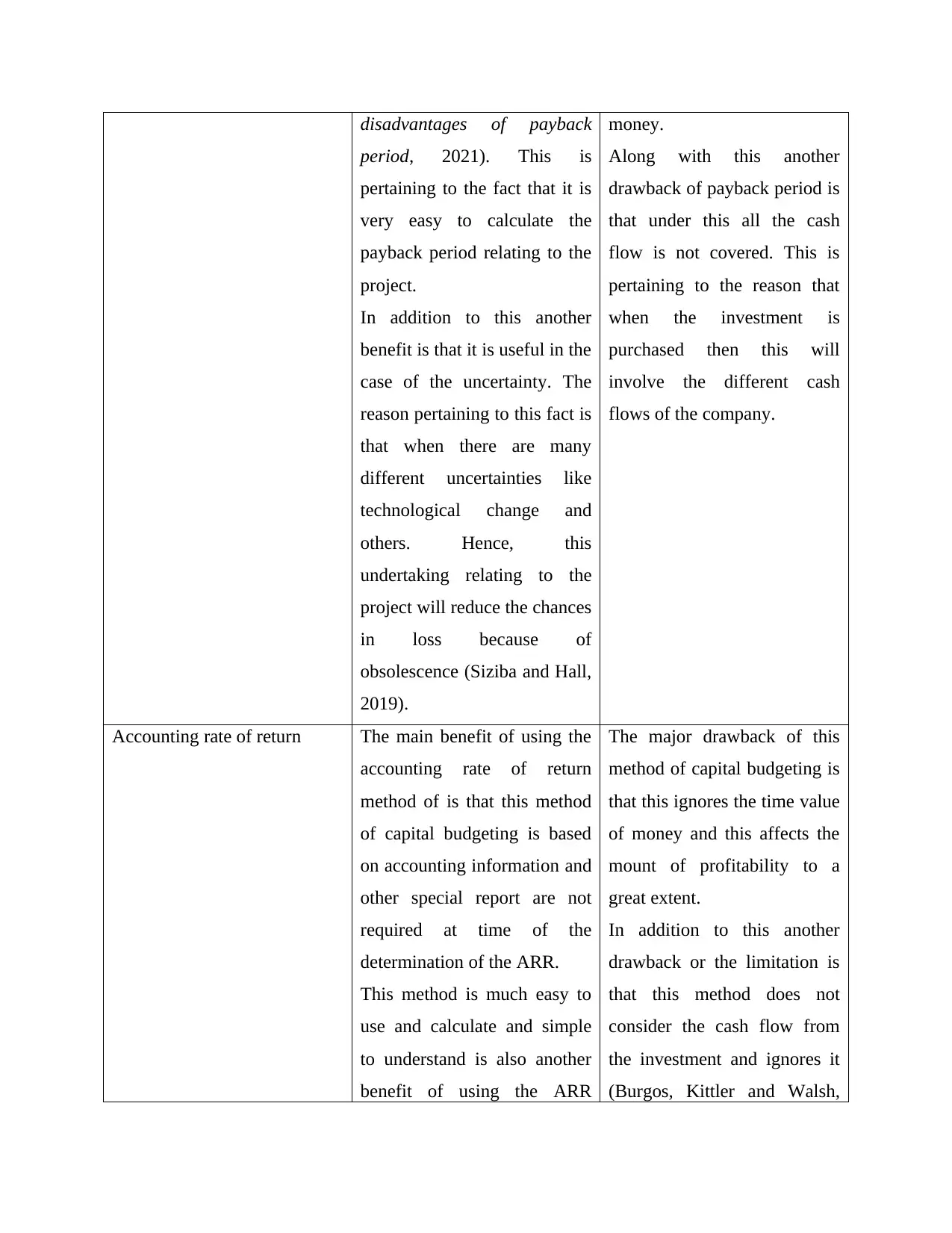
disadvantages of payback
period, 2021). This is
pertaining to the fact that it is
very easy to calculate the
payback period relating to the
project.
In addition to this another
benefit is that it is useful in the
case of the uncertainty. The
reason pertaining to this fact is
that when there are many
different uncertainties like
technological change and
others. Hence, this
undertaking relating to the
project will reduce the chances
in loss because of
obsolescence (Siziba and Hall,
2019).
money.
Along with this another
drawback of payback period is
that under this all the cash
flow is not covered. This is
pertaining to the reason that
when the investment is
purchased then this will
involve the different cash
flows of the company.
Accounting rate of return The main benefit of using the
accounting rate of return
method of is that this method
of capital budgeting is based
on accounting information and
other special report are not
required at time of the
determination of the ARR.
This method is much easy to
use and calculate and simple
to understand is also another
benefit of using the ARR
The major drawback of this
method of capital budgeting is
that this ignores the time value
of money and this affects the
mount of profitability to a
great extent.
In addition to this another
drawback or the limitation is
that this method does not
consider the cash flow from
the investment and ignores it
(Burgos, Kittler and Walsh,
period, 2021). This is
pertaining to the fact that it is
very easy to calculate the
payback period relating to the
project.
In addition to this another
benefit is that it is useful in the
case of the uncertainty. The
reason pertaining to this fact is
that when there are many
different uncertainties like
technological change and
others. Hence, this
undertaking relating to the
project will reduce the chances
in loss because of
obsolescence (Siziba and Hall,
2019).
money.
Along with this another
drawback of payback period is
that under this all the cash
flow is not covered. This is
pertaining to the reason that
when the investment is
purchased then this will
involve the different cash
flows of the company.
Accounting rate of return The main benefit of using the
accounting rate of return
method of is that this method
of capital budgeting is based
on accounting information and
other special report are not
required at time of the
determination of the ARR.
This method is much easy to
use and calculate and simple
to understand is also another
benefit of using the ARR
The major drawback of this
method of capital budgeting is
that this ignores the time value
of money and this affects the
mount of profitability to a
great extent.
In addition to this another
drawback or the limitation is
that this method does not
consider the cash flow from
the investment and ignores it
(Burgos, Kittler and Walsh,
Paraphrase This Document
Need a fresh take? Get an instant paraphrase of this document with our AI Paraphraser
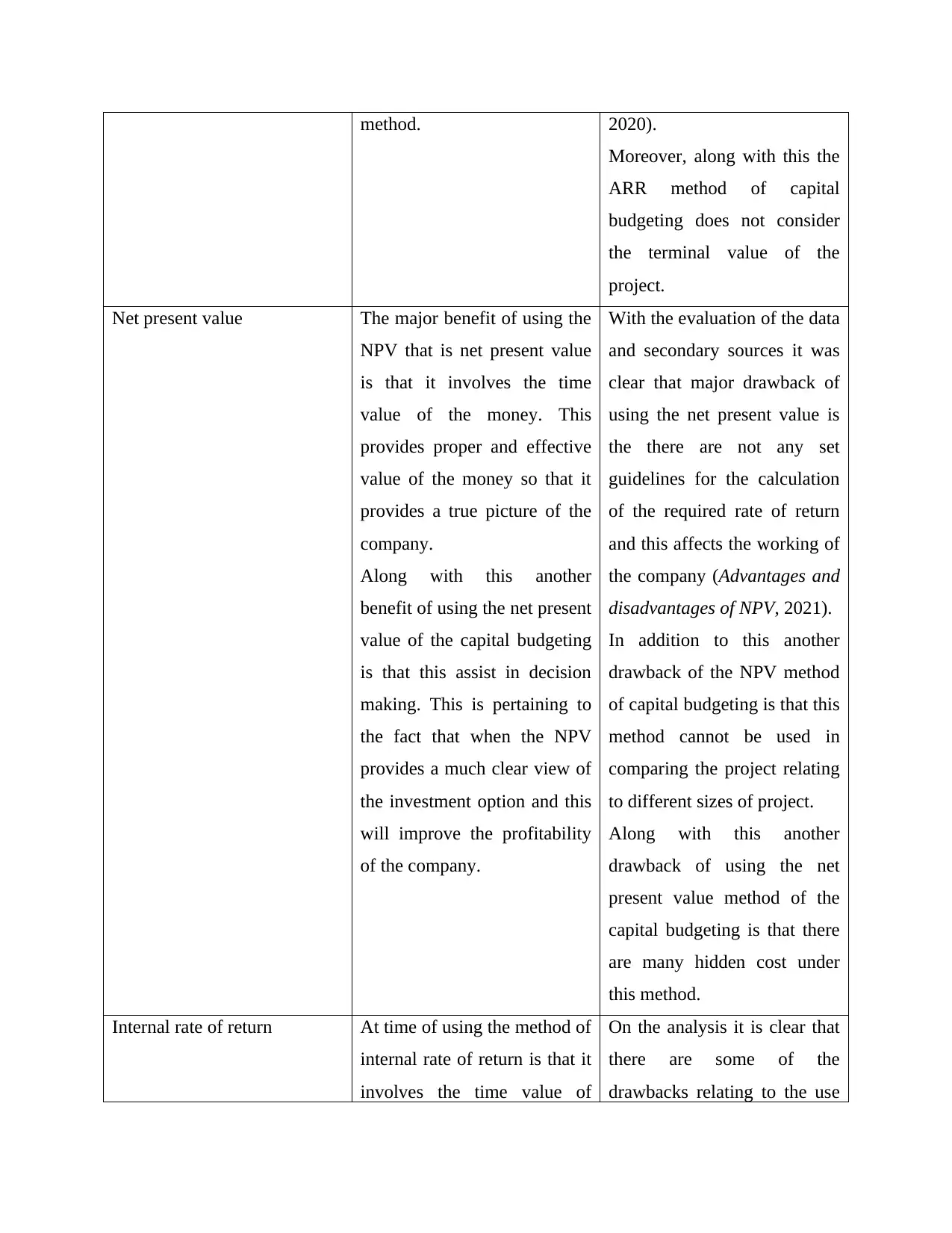
method. 2020).
Moreover, along with this the
ARR method of capital
budgeting does not consider
the terminal value of the
project.
Net present value The major benefit of using the
NPV that is net present value
is that it involves the time
value of the money. This
provides proper and effective
value of the money so that it
provides a true picture of the
company.
Along with this another
benefit of using the net present
value of the capital budgeting
is that this assist in decision
making. This is pertaining to
the fact that when the NPV
provides a much clear view of
the investment option and this
will improve the profitability
of the company.
With the evaluation of the data
and secondary sources it was
clear that major drawback of
using the net present value is
the there are not any set
guidelines for the calculation
of the required rate of return
and this affects the working of
the company (Advantages and
disadvantages of NPV, 2021).
In addition to this another
drawback of the NPV method
of capital budgeting is that this
method cannot be used in
comparing the project relating
to different sizes of project.
Along with this another
drawback of using the net
present value method of the
capital budgeting is that there
are many hidden cost under
this method.
Internal rate of return At time of using the method of
internal rate of return is that it
involves the time value of
On the analysis it is clear that
there are some of the
drawbacks relating to the use
Moreover, along with this the
ARR method of capital
budgeting does not consider
the terminal value of the
project.
Net present value The major benefit of using the
NPV that is net present value
is that it involves the time
value of the money. This
provides proper and effective
value of the money so that it
provides a true picture of the
company.
Along with this another
benefit of using the net present
value of the capital budgeting
is that this assist in decision
making. This is pertaining to
the fact that when the NPV
provides a much clear view of
the investment option and this
will improve the profitability
of the company.
With the evaluation of the data
and secondary sources it was
clear that major drawback of
using the net present value is
the there are not any set
guidelines for the calculation
of the required rate of return
and this affects the working of
the company (Advantages and
disadvantages of NPV, 2021).
In addition to this another
drawback of the NPV method
of capital budgeting is that this
method cannot be used in
comparing the project relating
to different sizes of project.
Along with this another
drawback of using the net
present value method of the
capital budgeting is that there
are many hidden cost under
this method.
Internal rate of return At time of using the method of
internal rate of return is that it
involves the time value of
On the analysis it is clear that
there are some of the
drawbacks relating to the use
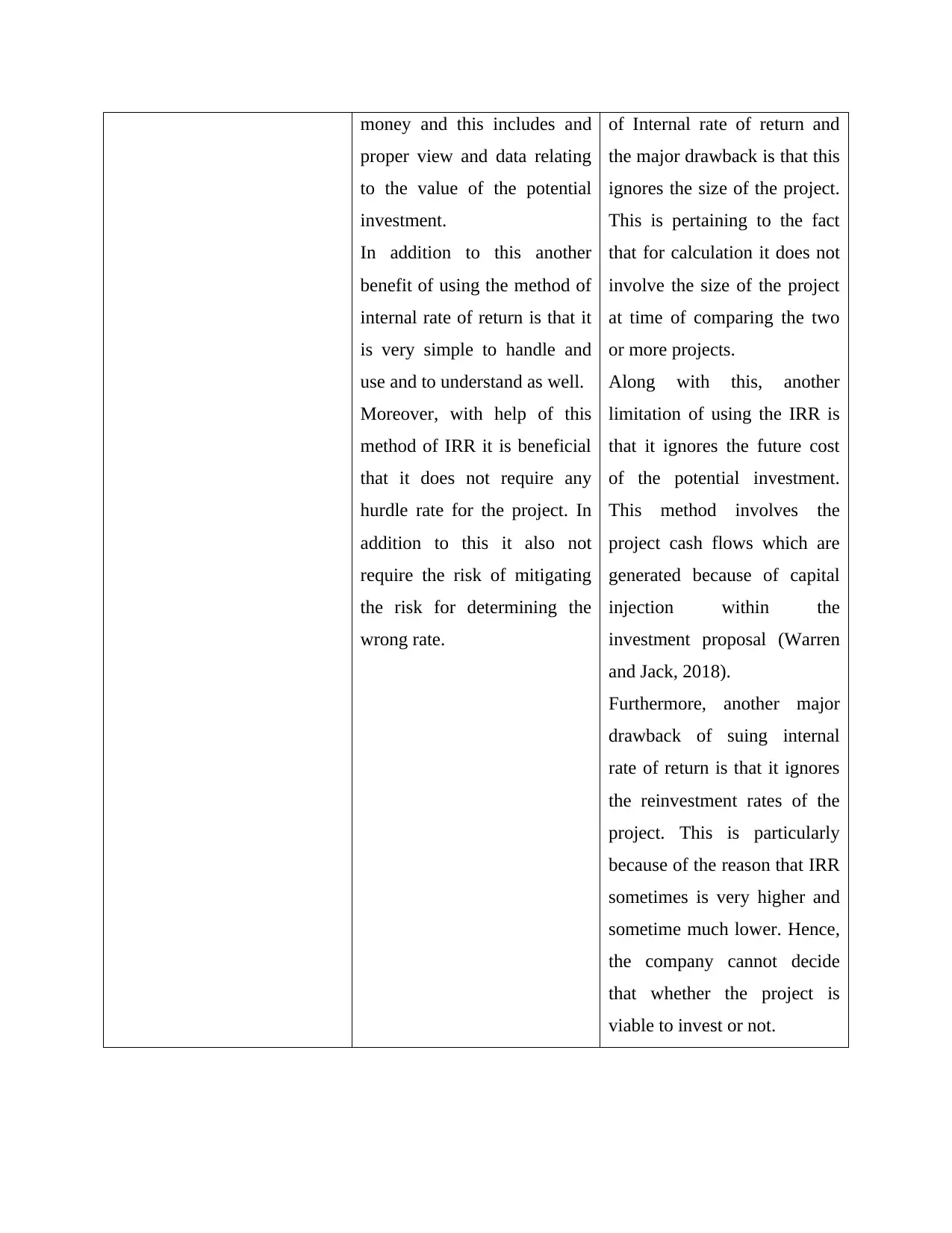
money and this includes and
proper view and data relating
to the value of the potential
investment.
In addition to this another
benefit of using the method of
internal rate of return is that it
is very simple to handle and
use and to understand as well.
Moreover, with help of this
method of IRR it is beneficial
that it does not require any
hurdle rate for the project. In
addition to this it also not
require the risk of mitigating
the risk for determining the
wrong rate.
of Internal rate of return and
the major drawback is that this
ignores the size of the project.
This is pertaining to the fact
that for calculation it does not
involve the size of the project
at time of comparing the two
or more projects.
Along with this, another
limitation of using the IRR is
that it ignores the future cost
of the potential investment.
This method involves the
project cash flows which are
generated because of capital
injection within the
investment proposal (Warren
and Jack, 2018).
Furthermore, another major
drawback of suing internal
rate of return is that it ignores
the reinvestment rates of the
project. This is particularly
because of the reason that IRR
sometimes is very higher and
sometime much lower. Hence,
the company cannot decide
that whether the project is
viable to invest or not.
proper view and data relating
to the value of the potential
investment.
In addition to this another
benefit of using the method of
internal rate of return is that it
is very simple to handle and
use and to understand as well.
Moreover, with help of this
method of IRR it is beneficial
that it does not require any
hurdle rate for the project. In
addition to this it also not
require the risk of mitigating
the risk for determining the
wrong rate.
of Internal rate of return and
the major drawback is that this
ignores the size of the project.
This is pertaining to the fact
that for calculation it does not
involve the size of the project
at time of comparing the two
or more projects.
Along with this, another
limitation of using the IRR is
that it ignores the future cost
of the potential investment.
This method involves the
project cash flows which are
generated because of capital
injection within the
investment proposal (Warren
and Jack, 2018).
Furthermore, another major
drawback of suing internal
rate of return is that it ignores
the reinvestment rates of the
project. This is particularly
because of the reason that IRR
sometimes is very higher and
sometime much lower. Hence,
the company cannot decide
that whether the project is
viable to invest or not.
⊘ This is a preview!⊘
Do you want full access?
Subscribe today to unlock all pages.

Trusted by 1+ million students worldwide

Question 3
a)Price earnings ratio= share price/earnings per share=4.15/29=0.14
The ratio is generally used to find whether the companies are over-valued or under-valued. It is
calculated in the denoted form and is an important ratio for investors to analyse. Generally, it
may be over valued and hence investors are careful in investing.
b) Discount cash flow method
cash flow=31000000
rate=12%
tax rate=21% of 31=21/100*31=6.51
31-6.51=24.49
=24.49/(1+12/100)^1+24.49/(1+12/100)^2+24.49/(1+12/100)^3+24.49/(1+12/100)^4+24.49/
(1+12/100)^5=88.28.
The discount cash flow method takes in consideration the cash flows over the years and finding
their present value with discount rate as assumption. This method has to be treated carefully for
calculations as minor fluctuations can make it go wrong in cash flow estimations.
c) Dividend valuation method=P=D1/r-g
P=stock price
D1=value of dividend of next year
R=cost of equity capital
G=growth rate in perpetuity
9/12-2.5+10.5/12-2.5+11/12-2.5+12/12-2.5+14/12-2.5=5.94.
The dividend valuation takes in account the dividend values over the years in consideration. The
perpetuity rate and cost of equity capital also are taken in consideration. Dividend valuation is
again looked up by investors while making mind on investing in a company. An investor would
like to see the continuity of dividends being paid by the company over the years and the
consistency of the company in maintaining dividends per share.
a)Price earnings ratio= share price/earnings per share=4.15/29=0.14
The ratio is generally used to find whether the companies are over-valued or under-valued. It is
calculated in the denoted form and is an important ratio for investors to analyse. Generally, it
may be over valued and hence investors are careful in investing.
b) Discount cash flow method
cash flow=31000000
rate=12%
tax rate=21% of 31=21/100*31=6.51
31-6.51=24.49
=24.49/(1+12/100)^1+24.49/(1+12/100)^2+24.49/(1+12/100)^3+24.49/(1+12/100)^4+24.49/
(1+12/100)^5=88.28.
The discount cash flow method takes in consideration the cash flows over the years and finding
their present value with discount rate as assumption. This method has to be treated carefully for
calculations as minor fluctuations can make it go wrong in cash flow estimations.
c) Dividend valuation method=P=D1/r-g
P=stock price
D1=value of dividend of next year
R=cost of equity capital
G=growth rate in perpetuity
9/12-2.5+10.5/12-2.5+11/12-2.5+12/12-2.5+14/12-2.5=5.94.
The dividend valuation takes in account the dividend values over the years in consideration. The
perpetuity rate and cost of equity capital also are taken in consideration. Dividend valuation is
again looked up by investors while making mind on investing in a company. An investor would
like to see the continuity of dividends being paid by the company over the years and the
consistency of the company in maintaining dividends per share.
Paraphrase This Document
Need a fresh take? Get an instant paraphrase of this document with our AI Paraphraser
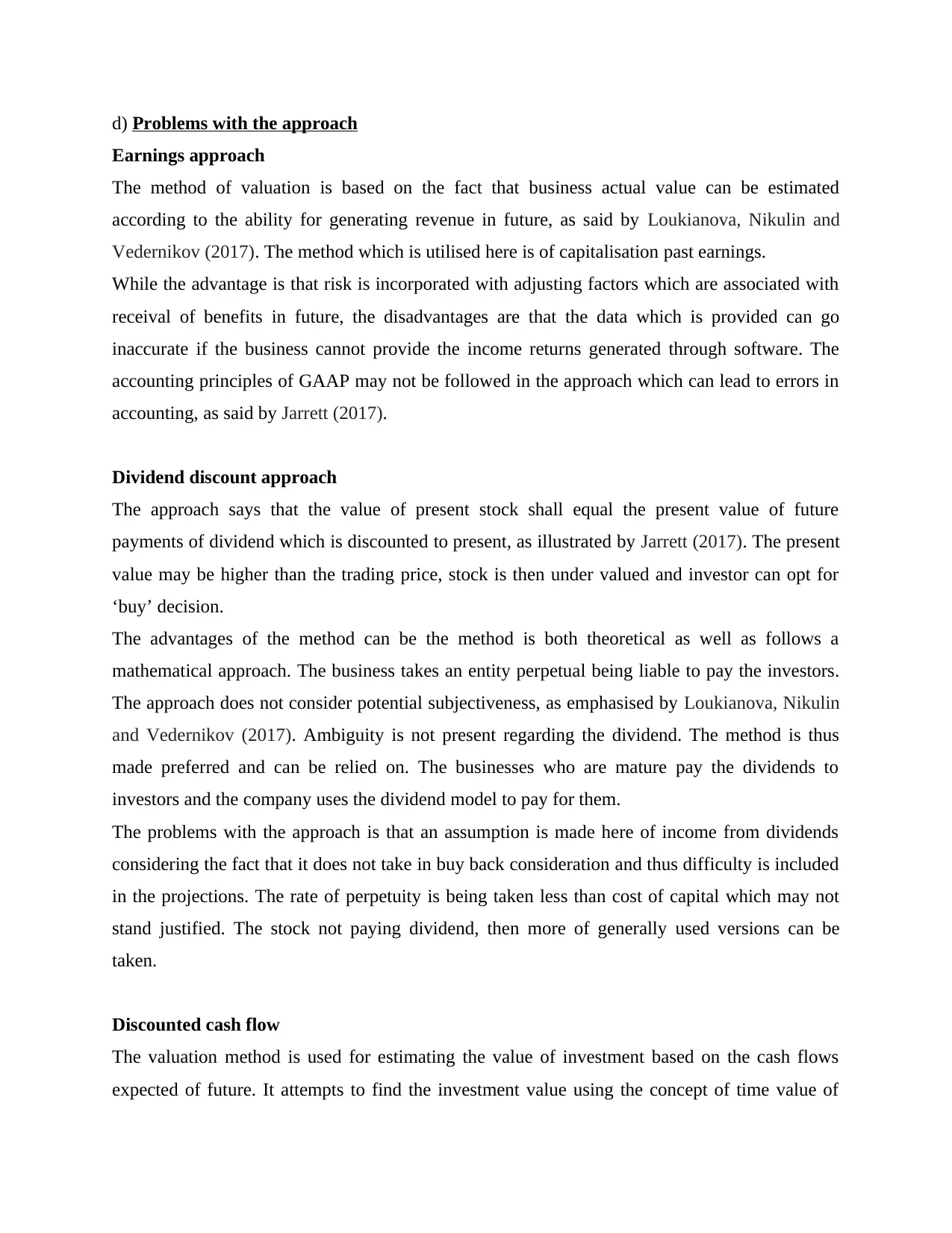
d) Problems with the approach
Earnings approach
The method of valuation is based on the fact that business actual value can be estimated
according to the ability for generating revenue in future, as said by Loukianova, Nikulin and
Vedernikov (2017). The method which is utilised here is of capitalisation past earnings.
While the advantage is that risk is incorporated with adjusting factors which are associated with
receival of benefits in future, the disadvantages are that the data which is provided can go
inaccurate if the business cannot provide the income returns generated through software. The
accounting principles of GAAP may not be followed in the approach which can lead to errors in
accounting, as said by Jarrett (2017).
Dividend discount approach
The approach says that the value of present stock shall equal the present value of future
payments of dividend which is discounted to present, as illustrated by Jarrett (2017). The present
value may be higher than the trading price, stock is then under valued and investor can opt for
‘buy’ decision.
The advantages of the method can be the method is both theoretical as well as follows a
mathematical approach. The business takes an entity perpetual being liable to pay the investors.
The approach does not consider potential subjectiveness, as emphasised by Loukianova, Nikulin
and Vedernikov (2017). Ambiguity is not present regarding the dividend. The method is thus
made preferred and can be relied on. The businesses who are mature pay the dividends to
investors and the company uses the dividend model to pay for them.
The problems with the approach is that an assumption is made here of income from dividends
considering the fact that it does not take in buy back consideration and thus difficulty is included
in the projections. The rate of perpetuity is being taken less than cost of capital which may not
stand justified. The stock not paying dividend, then more of generally used versions can be
taken.
Discounted cash flow
The valuation method is used for estimating the value of investment based on the cash flows
expected of future. It attempts to find the investment value using the concept of time value of
Earnings approach
The method of valuation is based on the fact that business actual value can be estimated
according to the ability for generating revenue in future, as said by Loukianova, Nikulin and
Vedernikov (2017). The method which is utilised here is of capitalisation past earnings.
While the advantage is that risk is incorporated with adjusting factors which are associated with
receival of benefits in future, the disadvantages are that the data which is provided can go
inaccurate if the business cannot provide the income returns generated through software. The
accounting principles of GAAP may not be followed in the approach which can lead to errors in
accounting, as said by Jarrett (2017).
Dividend discount approach
The approach says that the value of present stock shall equal the present value of future
payments of dividend which is discounted to present, as illustrated by Jarrett (2017). The present
value may be higher than the trading price, stock is then under valued and investor can opt for
‘buy’ decision.
The advantages of the method can be the method is both theoretical as well as follows a
mathematical approach. The business takes an entity perpetual being liable to pay the investors.
The approach does not consider potential subjectiveness, as emphasised by Loukianova, Nikulin
and Vedernikov (2017). Ambiguity is not present regarding the dividend. The method is thus
made preferred and can be relied on. The businesses who are mature pay the dividends to
investors and the company uses the dividend model to pay for them.
The problems with the approach is that an assumption is made here of income from dividends
considering the fact that it does not take in buy back consideration and thus difficulty is included
in the projections. The rate of perpetuity is being taken less than cost of capital which may not
stand justified. The stock not paying dividend, then more of generally used versions can be
taken.
Discounted cash flow
The valuation method is used for estimating the value of investment based on the cash flows
expected of future. It attempts to find the investment value using the concept of time value of
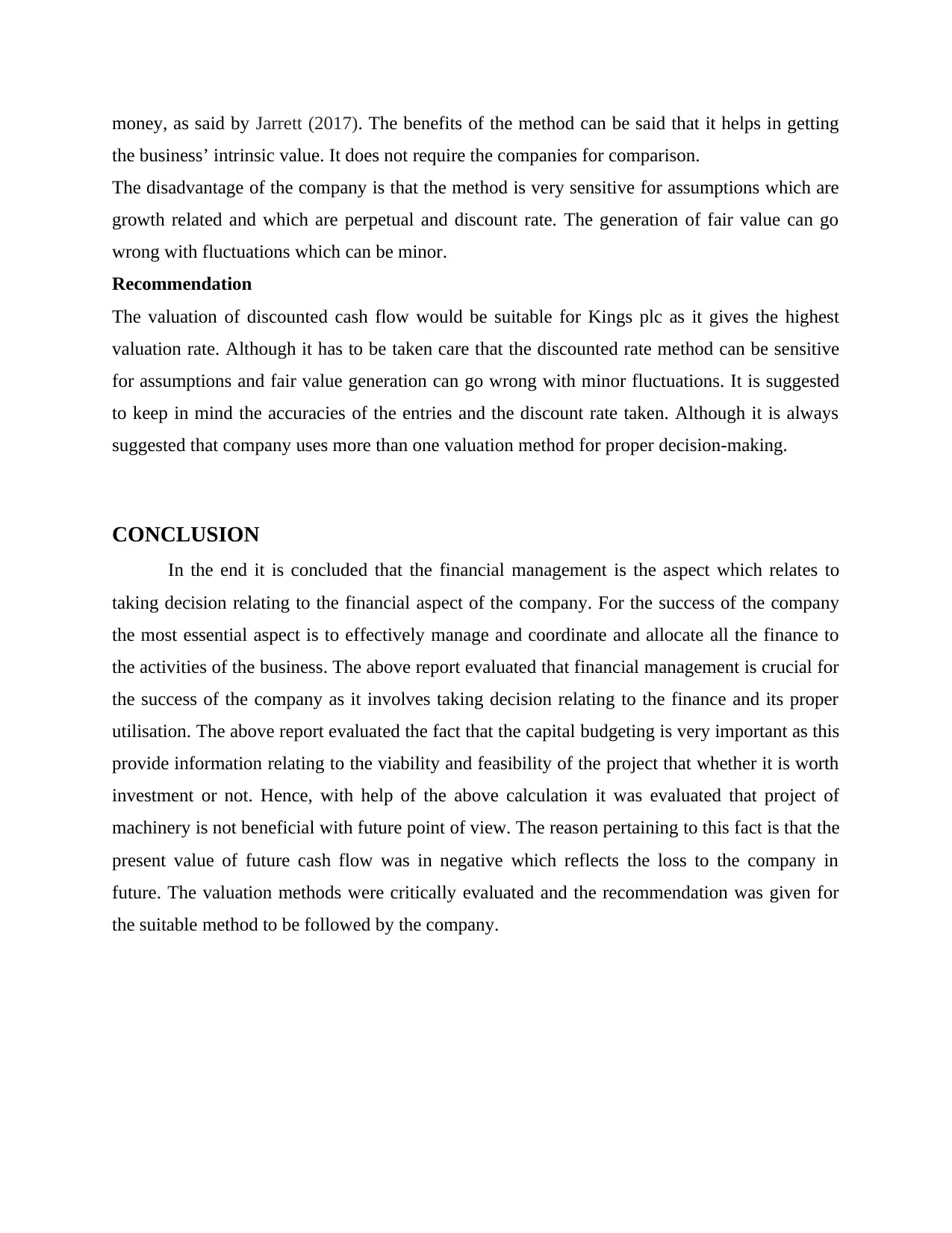
money, as said by Jarrett (2017). The benefits of the method can be said that it helps in getting
the business’ intrinsic value. It does not require the companies for comparison.
The disadvantage of the company is that the method is very sensitive for assumptions which are
growth related and which are perpetual and discount rate. The generation of fair value can go
wrong with fluctuations which can be minor.
Recommendation
The valuation of discounted cash flow would be suitable for Kings plc as it gives the highest
valuation rate. Although it has to be taken care that the discounted rate method can be sensitive
for assumptions and fair value generation can go wrong with minor fluctuations. It is suggested
to keep in mind the accuracies of the entries and the discount rate taken. Although it is always
suggested that company uses more than one valuation method for proper decision-making.
CONCLUSION
In the end it is concluded that the financial management is the aspect which relates to
taking decision relating to the financial aspect of the company. For the success of the company
the most essential aspect is to effectively manage and coordinate and allocate all the finance to
the activities of the business. The above report evaluated that financial management is crucial for
the success of the company as it involves taking decision relating to the finance and its proper
utilisation. The above report evaluated the fact that the capital budgeting is very important as this
provide information relating to the viability and feasibility of the project that whether it is worth
investment or not. Hence, with help of the above calculation it was evaluated that project of
machinery is not beneficial with future point of view. The reason pertaining to this fact is that the
present value of future cash flow was in negative which reflects the loss to the company in
future. The valuation methods were critically evaluated and the recommendation was given for
the suitable method to be followed by the company.
the business’ intrinsic value. It does not require the companies for comparison.
The disadvantage of the company is that the method is very sensitive for assumptions which are
growth related and which are perpetual and discount rate. The generation of fair value can go
wrong with fluctuations which can be minor.
Recommendation
The valuation of discounted cash flow would be suitable for Kings plc as it gives the highest
valuation rate. Although it has to be taken care that the discounted rate method can be sensitive
for assumptions and fair value generation can go wrong with minor fluctuations. It is suggested
to keep in mind the accuracies of the entries and the discount rate taken. Although it is always
suggested that company uses more than one valuation method for proper decision-making.
CONCLUSION
In the end it is concluded that the financial management is the aspect which relates to
taking decision relating to the financial aspect of the company. For the success of the company
the most essential aspect is to effectively manage and coordinate and allocate all the finance to
the activities of the business. The above report evaluated that financial management is crucial for
the success of the company as it involves taking decision relating to the finance and its proper
utilisation. The above report evaluated the fact that the capital budgeting is very important as this
provide information relating to the viability and feasibility of the project that whether it is worth
investment or not. Hence, with help of the above calculation it was evaluated that project of
machinery is not beneficial with future point of view. The reason pertaining to this fact is that the
present value of future cash flow was in negative which reflects the loss to the company in
future. The valuation methods were critically evaluated and the recommendation was given for
the suitable method to be followed by the company.
⊘ This is a preview!⊘
Do you want full access?
Subscribe today to unlock all pages.

Trusted by 1+ million students worldwide
1 out of 13
Related Documents
Your All-in-One AI-Powered Toolkit for Academic Success.
+13062052269
info@desklib.com
Available 24*7 on WhatsApp / Email
![[object Object]](/_next/static/media/star-bottom.7253800d.svg)
Unlock your academic potential
Copyright © 2020–2025 A2Z Services. All Rights Reserved. Developed and managed by ZUCOL.





